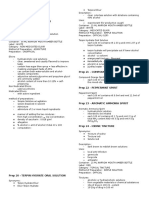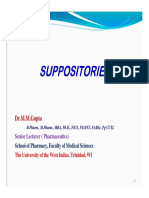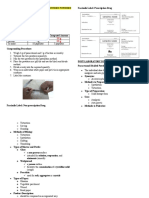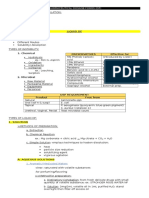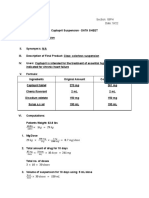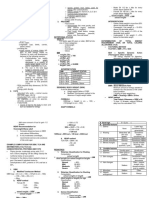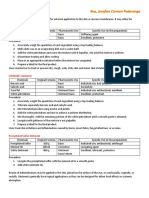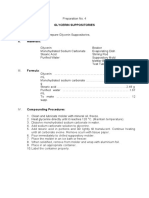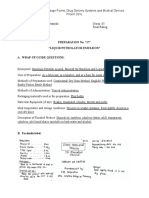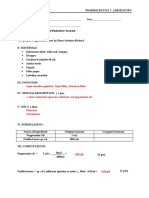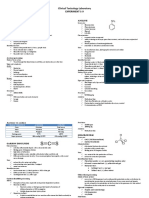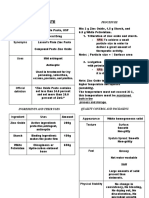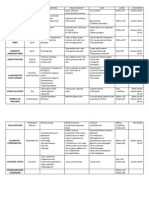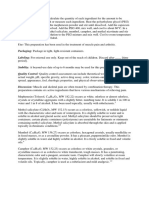Preparation Ointment
Preparation Ointment
Uploaded by
Lyanlie MinamotoCopyright:
Available Formats
Preparation Ointment
Preparation Ointment
Uploaded by
Lyanlie MinamotoOriginal Description:
Original Title
Copyright
Available Formats
Share this document
Did you find this document useful?
Is this content inappropriate?
Copyright:
Available Formats
Preparation Ointment
Preparation Ointment
Uploaded by
Lyanlie MinamotoCopyright:
Available Formats
Method of Preparation: Calculate the quantity of each ingredient for the amount to be
prepared. Accurately weigh or measure each ingredient. Heat the polyethylene glycol (PEG)
4,000 to about 75°C. Add the mephenesin powder and stir until dissolved. Add the capsicum
oleoresin and stir until dissolved. Add the PEG 400, mix well, and cool to about 60°C. In a
separate vessel, mix the methyl salicylate, menthol, camphor, and methyl nicotinate and stir
until dissolved. Add this solution to the PEG mixture and mix well. Cool to room temperature
while mixing. Package and label.
Use: This preparation has been used in the treatment of muscle pain and arthritis.
Packaging: Package in tight, light-resistant containers.
Labeling: For external use only. Keep out of the reach of children. Discard after ____ [time
period].
Stability: A beyond-use date of up to 6 months may be used for this preparation.1
Quality Control: Quality-control assessment can include theoretical weight compared with
actual weight, pH, specific gravity, active drug assay, color, texture–surface, texture–spatula
spread, appearance, feel, rheologic properties, and physical observations.2
Discussion: Muscle and skeletal pain are often treated by combination therapy. This
preparation contains six active ingredients that have various mechanisms of relieving pain.
Mephenesin (Tolserol, C10H14O3, MW 182.22) occurs as white, odorless or almost odorless,
crystals or crystalline aggregates with a slightly bitter, numbing taste. It is soluble 1 in 100 in
water and 1 in 8 of alcohol. It has been used topically, usually with rubefacients.3
Methyl salicylate (C8H8O3, MW 152.15) occurs as a colorless, yellowish, or reddish liquid
with the characteristic odor and taste of wintergreen. It is slightly soluble in water and is
soluble in alcohol and glacial acetic acid. Methyl salicylate should be preserved in tight
containers; certain plastic containers (polystyrene) are unsuitable for liniments or ointments
containing methyl salicylate. Methyl salicylate is absorbed through the skin and is applied
topically in rheumatic conditions.2,3
Menthol (C10H20O, MW 156.27) occurs as colorless, hexagonal crystals, usually needlelike or
in fused masses, or as a crystalline powder. It has a pleasant, peppermintlike odor. Menthol is
slightly soluble in water and highly soluble in alcohol. It is freely soluble in fixed and volatile
oils.4
Camphor (C10H16O, MW 152.23) occurs as colorless or white crystals, granules, or
crystalline masses or as colorless to white translucent, tough masses. It has a penetrating,
characteristic odor and a pungent, aromatic taste. Camphor will slowly volatilize at room
temperature. It is slightly soluble in water, highly soluble in alcohol, and soluble in fixed and
volatile oils. Topically, camphor is used as a rubefacient and mild analgesic.1,3
You might also like
- Water MucilagesDocument11 pagesWater MucilagesP100% (1)
- Calamine LotionDocument2 pagesCalamine LotionHeba Ali100% (1)
- Dds Laboratory Preparation 2: Magnesium Citrate Oral SolutionDocument4 pagesDds Laboratory Preparation 2: Magnesium Citrate Oral SolutionKate MendozaNo ratings yet
- PharDose Lab Prep 19-30Document4 pagesPharDose Lab Prep 19-30Angelyka Cabalo100% (1)
- Camphor Martin DaleDocument5 pagesCamphor Martin DalePatrick FlowerdayNo ratings yet
- Cold Cream FormDocument2 pagesCold Cream Formsskkale100% (1)
- 25 Rodriguez - Chapter 15-17Document9 pages25 Rodriguez - Chapter 15-17JANNIE BELLE RODRIGUEZNo ratings yet
- Unit 10-SuppositoriesDocument42 pagesUnit 10-SuppositoriesKimberly GeorgeNo ratings yet
- 22 30Document2 pages22 30Eunice AndradeNo ratings yet
- PH-PHR 214 Pharmaceutical Dosage Forms, Drug Delivery Systems, and Medical Devices LABDocument5 pagesPH-PHR 214 Pharmaceutical Dosage Forms, Drug Delivery Systems, and Medical Devices LABSeania BuenaventuraNo ratings yet
- This Study Resource Was Shared Via: Experiment 1: SyrupDocument4 pagesThis Study Resource Was Shared Via: Experiment 1: SyrupDanica BondocNo ratings yet
- Cold Cream USPDocument4 pagesCold Cream USPRon OlegarioNo ratings yet
- PHA6111LAB - Finals ReviewerDocument7 pagesPHA6111LAB - Finals ReviewerMarie Eloise BugayongNo ratings yet
- 02 Preparation 1 and 2Document4 pages02 Preparation 1 and 2James AzurinNo ratings yet
- DdsDocument9 pagesDdsClaudette JunioNo ratings yet
- PHAR 3 Preparation 16 Simple SyrupDocument2 pagesPHAR 3 Preparation 16 Simple SyrupDr.Ramkaran SainiNo ratings yet
- Dds Lab Prefi CoverageDocument9 pagesDds Lab Prefi CoverageErich ElloNo ratings yet
- PHARDOSE - Preparations 16-18 ReviewerDocument3 pagesPHARDOSE - Preparations 16-18 ReviewerFrances Jeiliane Javier0% (1)
- Aspirin ExpDocument4 pagesAspirin ExpLyrojen Mae TorralbaNo ratings yet
- Phardose PreparationsDocument9 pagesPhardose PreparationsMaggie Quinto100% (1)
- Prep 24 - Captropil SuspensionDocument3 pagesPrep 24 - Captropil SuspensionThe Dededo NativeNo ratings yet
- PH 107 DDS Lab Midterm NotesDocument11 pagesPH 107 DDS Lab Midterm NotesKrsna NaveraNo ratings yet
- Calcium Hydroxide Topical Solution 28Document2 pagesCalcium Hydroxide Topical Solution 28Thomas Niccolo Filamor ReyesNo ratings yet
- Health System Nutrition and DietDocument2 pagesHealth System Nutrition and DietMikaela LaoNo ratings yet
- Community Pharmacy Intern Exercises5-9Document6 pagesCommunity Pharmacy Intern Exercises5-9Joslin RozNo ratings yet
- Paracetamol TabletDocument3 pagesParacetamol TabletamebadhaNo ratings yet
- Dds Lab MidtermsDocument4 pagesDds Lab MidtermsJosefina Carmen RoaNo ratings yet
- 3RD Shifting Phardosage Lab ReviewerDocument14 pages3RD Shifting Phardosage Lab ReviewerMikaela LaoNo ratings yet
- Pharmaceutical SolutionsDocument29 pagesPharmaceutical SolutionsAhmed Imran KabirNo ratings yet
- Midterm DDS Lab Activity 2 - Group 01Document6 pagesMidterm DDS Lab Activity 2 - Group 01Omie PumbybyNo ratings yet
- Prep 10 PostlabDocument2 pagesPrep 10 PostlabKate MendozaNo ratings yet
- DISPLABPreps1 20 2Document21 pagesDISPLABPreps1 20 2Alexa Joy C. InguilloNo ratings yet
- Phardose Lab (Aromatic Water - Dakin's)Document5 pagesPhardose Lab (Aromatic Water - Dakin's)Sharmaine Margaret LeeNo ratings yet
- Preparation No. "17" "Liquid Petrolatum Emulsion" A. Wrap-Up Guide QuestionsDocument5 pagesPreparation No. "17" "Liquid Petrolatum Emulsion" A. Wrap-Up Guide QuestionsMEDELYN KEITH ESTANISLAONo ratings yet
- Analgesic OintmentDocument3 pagesAnalgesic OintmentTim BorjaNo ratings yet
- Post Lab 1 and 2Document5 pagesPost Lab 1 and 2Nikol BaltazarNo ratings yet
- Module 2 - Plant ChemistryDocument22 pagesModule 2 - Plant ChemistrySelena MoonNo ratings yet
- 03 Solutions PDFDocument77 pages03 Solutions PDFIra MoranteNo ratings yet
- Filling Ointment JarsDocument3 pagesFilling Ointment JarsAmit SinghNo ratings yet
- Dosage - Chapter 13Document5 pagesDosage - Chapter 13kaukau4ever100% (1)
- White Ointment ExDocument1 pageWhite Ointment ExHolihuaChua0% (1)
- Prep 22-27Document2 pagesPrep 22-27soubi_yodi100% (1)
- Phardose Lab (Prep 6-10)Document3 pagesPhardose Lab (Prep 6-10)Jan Aira Almazan100% (1)
- PHARDOSE LAB Preparation 21-31Document2 pagesPHARDOSE LAB Preparation 21-31Czarina Barcelon Daos75% (4)
- DFL E-25Document13 pagesDFL E-25Lea PesiganNo ratings yet
- Group 5 Pdis211 Lab E1Document22 pagesGroup 5 Pdis211 Lab E1Mikaela Kean JoseNo ratings yet
- Flexible Dominican Education (FDOME) Module BS Pharmacy ProgramDocument14 pagesFlexible Dominican Education (FDOME) Module BS Pharmacy ProgramSHEENA JOY HABITANNo ratings yet
- DFL E-29 Gel and LotionDocument39 pagesDFL E-29 Gel and LotionFersan AngelesNo ratings yet
- Pcog Notes GlycosidesDocument8 pagesPcog Notes GlycosidesAlexandra Venice ChuaNo ratings yet
- Pharmaceutical GranulesDocument55 pagesPharmaceutical GranulesWalaa abo foolNo ratings yet
- Emulsions: (A) Dilution TestDocument5 pagesEmulsions: (A) Dilution TestEman AzizNo ratings yet
- GROUP 1 Prep-14 Data SheetDocument2 pagesGROUP 1 Prep-14 Data SheetTrisha ArgaoNo ratings yet
- ToxiiiiiiDocument6 pagesToxiiiiiiRaya Ibarra LumogdangNo ratings yet
- Pharm. Chem. - 2 Lab Exp No 5Document3 pagesPharm. Chem. - 2 Lab Exp No 5davenNo ratings yet
- Prep 4 Post LabDocument2 pagesPrep 4 Post LabKate MendozaNo ratings yet
- Acyclovir 200 MG Vaginal InsertDocument8 pagesAcyclovir 200 MG Vaginal InsertatjaiNo ratings yet
- Ibuprofen 5% Topical CreamDocument1 pageIbuprofen 5% Topical CreamSameed BashaNo ratings yet
- EX-Featured Excipient Capsule and Tablet LubricantsDocument20 pagesEX-Featured Excipient Capsule and Tablet Lubricantsraju1559405No ratings yet
- Excipients ProfileDocument7 pagesExcipients ProfileTamilarasan DeenathayalanNo ratings yet
- Idoxuridine 0.5% Ophthalmic OintmentDocument1 pageIdoxuridine 0.5% Ophthalmic Ointmentmd_corona62No ratings yet
- Ointment Cream and GelsDocument79 pagesOintment Cream and GelsGwyneth Cartalla100% (2)
- Presentation Sandeep Cool Hair OilDocument35 pagesPresentation Sandeep Cool Hair OilSandeep Sankar PaulNo ratings yet
- Formulas - Fenners Complete Formulary Part 4Document118 pagesFormulas - Fenners Complete Formulary Part 4sanyu33333No ratings yet
- UNITII Terpenes PDFDocument15 pagesUNITII Terpenes PDFBharti sainNo ratings yet
- Karkhana Zindatilismath-FinalDocument35 pagesKarkhana Zindatilismath-Finalsrikalyani2k9100% (1)
- 26 HawanTechniqueDocument8 pages26 HawanTechniqueArpan BhattacharyaNo ratings yet
- Synthesis of Camphor by The Oxidation of BorneolDocument6 pagesSynthesis of Camphor by The Oxidation of BorneolCyrene MBolañosNo ratings yet
- Liniments - 1 ST B Pharm and 1st Pharm D NotesDocument5 pagesLiniments - 1 ST B Pharm and 1st Pharm D NotesRasla MolNo ratings yet
- Resins Uses in AstrologyDocument6 pagesResins Uses in Astrologytirendra sisodiaNo ratings yet
- Arnica Montana-Based Product For Treating Joint Pain - Flexogor - Is Prepared For Sale in AsiaDocument2 pagesArnica Montana-Based Product For Treating Joint Pain - Flexogor - Is Prepared For Sale in AsiaPR.comNo ratings yet
- BORNEOLDocument43 pagesBORNEOLChelliebi Rivera EbuengaNo ratings yet
- Phardose FinalsDocument2 pagesPhardose FinalsAnna Patricia Berza100% (1)
- Beyond Ben Gay-ADocument17 pagesBeyond Ben Gay-AsadyNo ratings yet
- GuideDocument236 pagesGuideBenjamin TantiansuNo ratings yet
- CamphorDocument7 pagesCamphorashNo ratings yet
- Treatment and Prevention of CholeraDocument6 pagesTreatment and Prevention of CholeraMickelleCostantinoSheaNo ratings yet
- BoondocksDocument1 pageBoondocksLeslie Joy YataNo ratings yet
- Bhimseni CamphorDocument3 pagesBhimseni CamphorDhaval SoniNo ratings yet
- LIST OF REGISTERED DRUGS As of December 2012: DR No Generic Brand Strength Form CompanyDocument163 pagesLIST OF REGISTERED DRUGS As of December 2012: DR No Generic Brand Strength Form CompanyBenjamin TantiansuNo ratings yet
- Title of Monograph: Cinnamomum CamphoraDocument11 pagesTitle of Monograph: Cinnamomum CamphoraDyar Mzafar100% (1)
- Preparation OintmentDocument1 pagePreparation OintmentLyanlie MinamotoNo ratings yet
- Zam-Buk Ointment - PI - ZA-v2 122020Document6 pagesZam-Buk Ointment - PI - ZA-v2 122020askeladd333No ratings yet
- CamphorDocument16 pagesCamphorSunitha Katta0% (1)
- 13 - CH-475 - Terpenes - CamphorDocument6 pages13 - CH-475 - Terpenes - CamphorUrva AmjadNo ratings yet
- Sinarest Vapocap2018Document2 pagesSinarest Vapocap2018v mannNo ratings yet
- Volatile Oils Part BDocument42 pagesVolatile Oils Part BMohamedNo ratings yet
- Vol OilsDocument49 pagesVol OilshelenyakhyNo ratings yet
- Ointment Box OutlineDocument1 pageOintment Box OutlineDon Nestor Razon Jr.No ratings yet
- 2460 PDFDocument5 pages2460 PDFChandrika DasNo ratings yet
- Introduction of TerpenoidsDocument17 pagesIntroduction of TerpenoidsAbdul WahhabNo ratings yet



